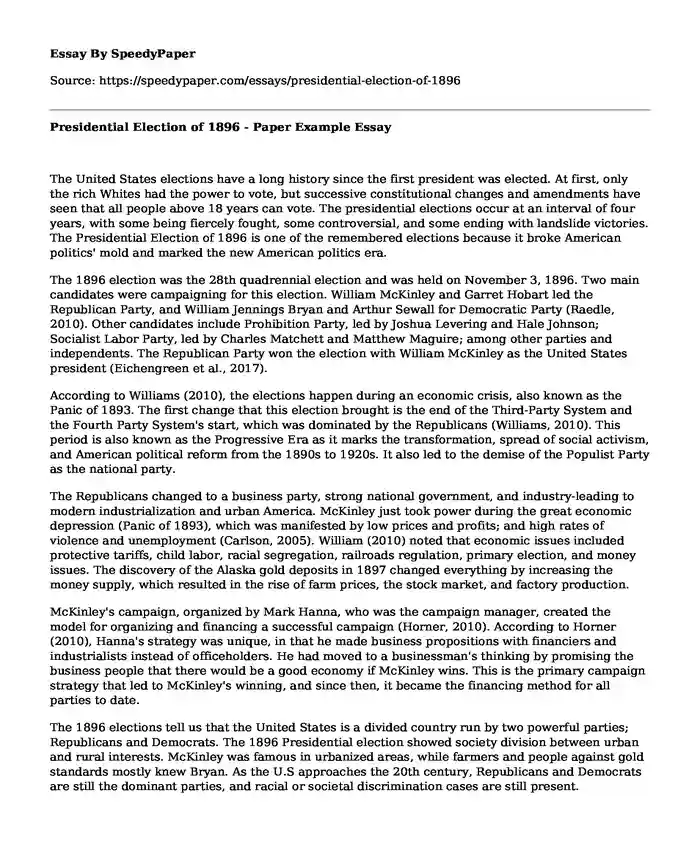
| Type of paper: | Essay |
| Categories: | United States Government American history |
| Pages: | 3 |
| Wordcount: | 656 words |
The United States elections have a long history since the first president was elected. At first, only the rich Whites had the power to vote, but successive constitutional changes and amendments have seen that all people above 18 years can vote. The presidential elections occur at an interval of four years, with some being fiercely fought, some controversial, and some ending with landslide victories. The Presidential Election of 1896 is one of the remembered elections because it broke American politics' mold and marked the new American politics era.
The 1896 election was the 28th quadrennial election and was held on November 3, 1896. Two main candidates were campaigning for this election. William McKinley and Garret Hobart led the Republican Party, and William Jennings Bryan and Arthur Sewall for Democratic Party (Raedle, 2010). Other candidates include Prohibition Party, led by Joshua Levering and Hale Johnson; Socialist Labor Party, led by Charles Matchett and Matthew Maguire; among other parties and independents. The Republican Party won the election with William McKinley as the United States president (Eichengreen et al., 2017).
According to Williams (2010), the elections happen during an economic crisis, also known as the Panic of 1893. The first change that this election brought is the end of the Third-Party System and the Fourth Party System's start, which was dominated by the Republicans (Williams, 2010). This period is also known as the Progressive Era as it marks the transformation, spread of social activism, and American political reform from the 1890s to 1920s. It also led to the demise of the Populist Party as the national party.
The Republicans changed to a business party, strong national government, and industry-leading to modern industrialization and urban America. McKinley just took power during the great economic depression (Panic of 1893), which was manifested by low prices and profits; and high rates of violence and unemployment (Carlson, 2005). William (2010) noted that economic issues included protective tariffs, child labor, racial segregation, railroads regulation, primary election, and money issues. The discovery of the Alaska gold deposits in 1897 changed everything by increasing the money supply, which resulted in the rise of farm prices, the stock market, and factory production.
McKinley's campaign, organized by Mark Hanna, who was the campaign manager, created the model for organizing and financing a successful campaign (Horner, 2010). According to Horner (2010), Hanna's strategy was unique, in that he made business propositions with financiers and industrialists instead of officeholders. He had moved to a businessman's thinking by promising the business people that there would be a good economy if McKinley wins. This is the primary campaign strategy that led to McKinley's winning, and since then, it became the financing method for all parties to date.
The 1896 elections tell us that the United States is a divided country run by two powerful parties; Republicans and Democrats. The 1896 Presidential election showed society division between urban and rural interests. McKinley was famous in urbanized areas, while farmers and people against gold standards mostly knew Bryan. As the U.S approaches the 20th century, Republicans and Democrats are still the dominant parties, and racial or societal discrimination cases are still present.
In conclusion, the election of 1896 created modern politics in the United States, with McKinley as the president. The reign of Republicans or the start of the Fourth Party System was also during this period. During this era, the discovery of gold led to the overcome of economic depression by rise of prices and urbanization. The America we know today probably started from this election.
References
Carlson, M. (2005). Causes of Bank Suspensions in the Panic of 1893. Explorations in Economic History, 42(1), 56–80.
Eichengreen, B., Haines, M., Jaremski, M., & Leblang, D. (2017, October 25). Economic factors in the 1896 presidential election. VOX, CEPR Policy Portal. https://voxeu.org/article/economic-factors-1896-presidential-election.
Horner, W. T. (2010). Ohio's Kingmaker: Mark Hanna, man & myth. Ohio University Press.
Raedle, J. (2010, January 8). Presidential Elections. History.com. https://www.history.com/topics/us-presidents/presidential-elections-1.
Williams, R. H. (2010). Realigning America: McKinley, Bryan, and the remarkable election of 1896. University Press of Kansas.
Cite this page
Presidential Election of 1896 - Paper Example. (2024, Jan 28). Retrieved from https://speedypaper.net/essays/presidential-election-of-1896
Request Removal
If you are the original author of this essay and no longer wish to have it published on the SpeedyPaper website, please click below to request its removal:
- Free Essay on Why Leaking Classified Information Is Wrong
- Essay Example on Development Federalism
- Fiscal Policy
- Essay Example: Aid Organization Report
- Essay Sample with Rhetorical Analysis: The Declaration of Independence
- Ethical Quandaries in Corporate Governance: A Case Study of Employee Relationships and Decision-Making
- To What Extent is Democracy in America a Celebration of Democracy? - Essay Sample
Popular categories




